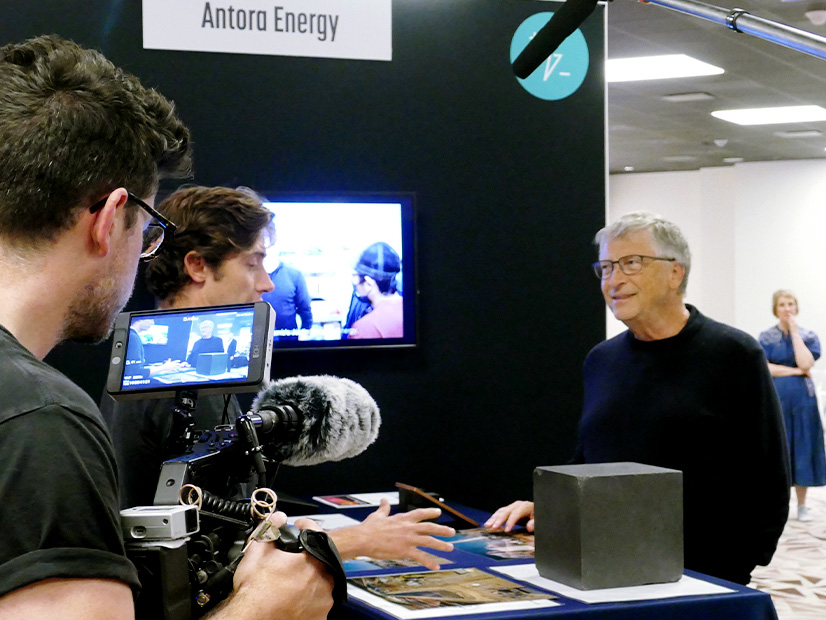To achieve its net-zero targets by 2050, the United States will need a major deployment of bioenergy paired with carbon capture and storage (BECCS), with a goal of sequestering 500 million metric tons (MMT) of carbon dioxide per year, according to a new report from the Energy Futures Initiative (EFI).
Ethanol from corn and biodiesel from cooking oil are the most common forms of bioenergy, but the report sees wider options for feedstock, such as agricultural waste or trees and underbrush culled for forestry management. It also stakes out a claim for BECCS as a carbon-negative technology, taking more carbon out of the atmosphere than it emits, which could “counterbalance residual emissions from difficult-to-decarbonize sectors of the economy.”
“We know there are voices that would prefer other pathways toward very deep decarbonization,” said Ernest Moniz, former U.S. secretary of energy and EFI’s CEO. “But the reality is ― in our view, has been consistently ― that we need all [technologies] because the fight … for every damn tenth of a degree is really important.”
Speaking at a recent launch event for the report, Moniz cited figures from the United Nations International Panel on Climate Change, projecting that carbon dioxide removal technologies will need to cut global emissions by 6 gigatons per year by midcentury to keep climate change to 1.5 or 2 degrees Celsius. About half of that total could come from BECCS, Moniz said.
“And to put that in context, that 6 gigatons … is larger than the total U.S. emissions today of carbon dioxide,” he said. “So, this is not for the faint of heart. We’re going to need a very, very substantial effort.”
A gigaton is one billion tons, and the most recent figures from the Environmental Protection Agency, for 2021, peg U.S. CO2 emissions at 5.58 MMT.
The EFI report outlines what that substantial effort might look like, from setting ambitious goals, to expanding sources of biomass, to enacting supportive federal policies, such as tax incentives and changes to the Farm Bill now being debated in Congress. Last amended and reauthorized in 2018, the Farm Bill is updated every five years.
EFI recommends the 2023 update include increased funding for BECCS research and the inclusion of BECCS in existing programs, such as the Advanced Biofuels Payment Program, which provides financial support for biofuels not based on corn.
The report also sees a major opportunity to increase BECCS feedstocks through forest management, harvesting fast-growing trees and other plants that can result in “overstocked” forestlands and increased risk of wildfires. Citing a study from Yale University and the University of California, Berkeley, the report estimates “that between 265 million and 1 billion bone-dry tons (BDT) of biomass overstock are in wildfire prone counties in five Western states alone (California, Idaho, Nevada, Oregon and Washington).”
A bone-dry ton is a measure of wood with zero moisture content.
“BECCS creates a value proposition for more active forest wildfire management by providing a market for this overstocked biomass,” the report says. Job creation and economic development for rural communities would be another strong selling point, the report says.
But federal regulations strictly limit the use of forest biomass harvested from federal lands for biofuel production, the report says. For example, biofuels made from biomass harvested from federal forests do not qualify for EPA’s Renewable Fuel Standard. The EFI report recommends that exclusion be lifted.
Neutral or Negative?
With the world’s hottest days on record grabbing headlines, Moniz’s call for all-of-the-above climate action is timely and undeniable, but like carbon capture itself, BECCS raises skepticism and a lot of questions among environment groups.
EFI’s basic argument for BECCS begins with its claim that bioenergy is essentially carbon neutral — that is, the CO2 naturally sequestered in wood or other organic matter via photosynthesis offsets the carbon emitted when that feedstock is burned or otherwise processed to produce biofuels or other energy. Storing those emissions underground or sequestering them by other means makes them, at least potentially, carbon negative, said Joseph S. Hezir, EFI’s executive vice president.
“Depending on where you want to start the cycle, you could either have the carbon intake up front and then release [it] later or the release now and then capture or recapture later,” Hezir said in an interview with NetZero Insider.
EFI also notes that biomass already is the largest source of renewable energy in the U.S., based on figures from the International Energy Agency (IEA), which include its use in ethanol and other biofuels. Biomass is more widely used for heat and power generation in Europe, but it accounts for only 1.3% of power generation in the U.S, according to the U.S. Energy Information Administration.
An analysis from the National Resources Defense Council (NRDC) disputes the carbon neutrality of bioenergy, arguing such calculations leave out emissions associated with the full supply chain of procuring and transporting biomass.
“Far from being carbon negative, the lifecycle of this approach to BECCS generates about 80% as much carbon as comes out of a coal plant smokestack per megawatt-hour. This is because a large fraction of the total emissions occur off-site,” according to an NRDC issue brief.
Echoing NRDC, a Sierra Club analysis says, “The process of vegetation capturing CO2 from the atmosphere is carbon negative. Transporting those plants and refining, capturing and storing CO2 is not. For BECCS to be carbon negative, all of the above would have to be done with renewable energy.”
NRDC also raises concerns that widespread deployment of BECCS “would tax global ecological limits, threaten public health and cost a fortune.”
Food vs. Fuel
The EFI report acknowledges the carbon accounting, land use and economic obstacles BECCS will have to overcome and calls for “responsible” development of the technology.
One of the report’s key priorities is the development of “science-based, transparent guidelines for estimating … [greenhouse gas] emissions contributions from BECCS,” while also noting the challenges of building consensus and confidence for such guidelines. For example, given the wide range of bioenergy feedstocks, developing science-based carbon accounting will be complicated, Hezir said.
Tracking CO2 emissions is “different for crops than it is for forestry,” he said. “Forestry is … particularly challenging because forests sometimes are managed at a very macro level, where you might be planting in one area and harvesting in another, and then the question is how [do] you look at that whole landscape?”
Similarly, carbon accounting for agriculture will have to take into account fertilizers, irrigation and harvesting, Hezir said.
Roger Ballentine, president of Green Strategies, an industry consultant, said carbon accounting for BECCS should look at what the technology delivers “on a systemic basis,” rather than using a lifecycle analysis of individual BECCS facilities or feedstocks.
“What’s the decarbonization impact of providing [different] funding streams?” Ballentine said during a panel at the launch event. “You have energy production. You have carbon dioxide removal. You may have wildfire mitigation and waste management. So how do these opportunities and some of the challenges … compare to other pathways, especially carbon dioxide removal?”
The land use issue is another major challenge, pitting food production against “energy crops” used for fuel, said Virginia H. Dale, a corporate fellow at Oak Ridge National Laboratory. But, she said, “The U.S. has a large amount of nonfood crops, waste and forest residues that can provide biomass for this expanded BECCS deployment. … More than 300 million tons of biomass are readily available from currently unused agriculture and forestry waste, as well as including municipal waste. …
“We need to recognize that food and bioenergy … don’t need to compete for land. They could be integrated together to provide an appropriate resource for both of these if managed collectively. One thing we can do is develop flex crops, that is … resources that can be used for fuels as well as food, so that when there’s a food need, they can be adapted to that.”
Compared to direct air capture technologies, the economics of BECCS also requires a systemic approach that includes its potential to provide firm, dispatchable power to the electric power grid, said Sasha Mackler, executive director of the Energy Program at the Bipartisan Policy Center.
Direct air capture’s business model is simpler, he said. “You need to have a technology system that can effectively and efficiently capture carbon. We really have one product you’re selling: carbon removal.”
Widespread deployment of BECCS will require monetizing multiple value streams, such as power production, carbon removal and forest management for wildfire prevention, which will in turn depend on figuring out the carbon accounting, Mackler said.
“For product developers to actually get to the work of building out this business, they need to have clarity on what they’re able to monetize,” he said.
Ballentine also noted that the Inflation Reduction Act’s generous tax credits for carbon capture — up to $180/ton for direct air capture — do not specifically incentivize carbon-negative technologies. Further, he said, expanding biomass supply “doesn’t do you any good if there’s not demand.”
Will There be Demand?
Besides monetization, applications that build demand for BECCS could be the biggest roadblock to widespread deployment.
While supporting carbon removal technologies in general, the IEA cautions they should not be used as “an alternative to cutting emissions or an excuse for delayed action. But they can be part of the portfolio of technologies and measures needed in a comprehensive response to climate change.”
Hezir sees near-term applications for biofuels like renewable natural gas and sustainable aviation fuels, both areas where emerging demand exists among well-established industries, in this case, utilities and airlines. For example, the Renewable Natural Gas Coalition, an industry trade group, counts major utilities such as Consolidated Edison, National Grid, Dominion Energy, and Pacific Gas and Electric among its members.
Longer term, the EFI report sees much potential for BECCS, but also uncertainties that will require new policies and investments. “We’re now at a stage where we actually need to deploy more pilot projects, collect data and get more learning,” Hezir said. “Then use that to grow the industry.”

